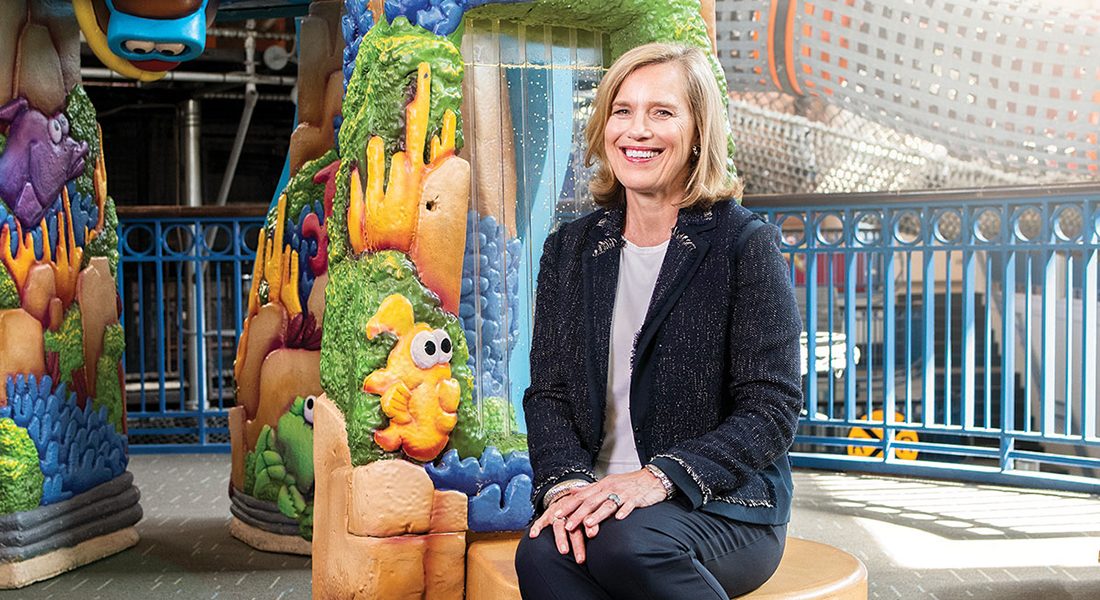Education & Family
Cameo: Bryn Parchman
We talk with the president and CEO of Port Discovery Children's Museum.
How did you begin working with children’s museums?
I started out in the for-profit world, specifically corporate banking and then marketing and communications. I was involved with the children’s museums in Minneapolis and Richmond before I ended up in Baltimore and started at the Cloisters children’s museum, but I was still pursuing my for-profit career during that time.
What influenced you to leave the for-profit world and work at the children’s museum full-time?
I had always seen and believed in the power of a children’s museums’ place in a community. I really believed in what children’s museums were doing. I had the opportunity to take a six-month leave from my “real job” to help start Port Discovery, and it turned into my passion because I love what we do here. For me, this role combines my for-profit and non-profit background in a way that comes together beautifully. I feel very lucky.
How do you see Port Discovery’s role in the community?
When the museum first opened in 2008, we used the expression, “If you can dream it, you can do it” and we still believe and work by that today. Our role is to open doors for kids and open their minds and their families’ minds to new possibilities. For example, we’ve had so many teachers tell us that they could talk about Egypt all day in the classroom with little response from the kids, but when they walk into a sarcophagus and see inside a mummy in our Egypt exhibit, then it means something to them.
We strive to be a gateway experience—meaning that if they love the Egypt exhibit here, then maybe they’ll visit the Egypt exhibit at The Walters Art Museum next. Given everything that’s happened in Baltimore over the past couple of years, it makes me believe even more in the possibilities that we can make for the children and families who live here. We’ve barely made a dent, and we’ve got a lot of good work to do.
The museum is in the midst of a $10.5 million capital campaign. What can visitors expect to see as a result?
We’ve had more than five million visitors since we’ve opened, and, as you can imagine, five million little hands touching and pulling on everything takes its toll. We thought a lot about how families, teachers, and members use the museum, and we surveyed them about what they needed from us. Our big additions will be the port exhibit and the new four-story SkyClimber [climbing structure].
We’re also adding more seating and gathering places throughout the museum, as well as simple upgrades to bathrooms and nursing areas. A lot of the research has come out in the past few years about how kids learn and process, and we want to put that new information into play at the museum.
How does that apply to the new port exhibit?
We think of the Port of Baltimore as a metaphor for how kids learn—things come in, things go out—and we use [the port] as a way for kids to learn about processes that happen outside of their neighborhood but impact their everyday lives. We start with a simple question like, “How did you get the sneakers that are on your feet? What are all of the jobs involved with making that happen?”
We’re all about teamwork, imagination, and curiosity, and we want kids to think about how things came together using simple geography. It’s about using the exhibit to open up their eyes to new possibilities—we want them to walk in and picture themselves being the captain of that ship or being a stevedore.
During your time as president, you’ve launched several initiatives to make the museum more accessible to underserved communities. Where did that motivation come from and why is it important?
I’ve always felt strongly that the role of a children’s museum is to be accessible to as many people as possible. Some people can’t afford to buy a ticket or may not feel that a museum is a place for them, but if they can come here and feel engaged then we can act as an entryway to other institutions in the city. Access is in our DNA in terms of who we are as an institution, and if you walk through the museum on any given day, you feel that this is a place for everyone.
